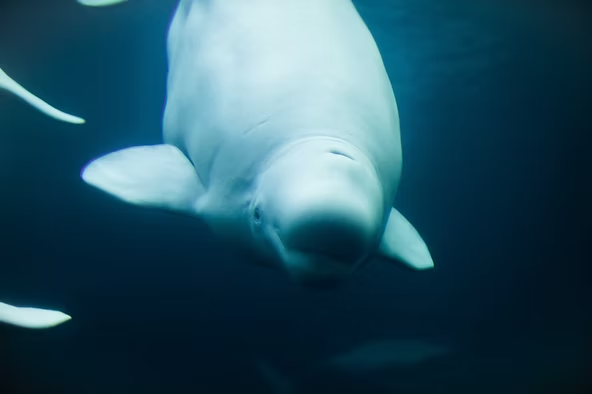Beluga Whales: The Arctic “Sea Canaries”
Belugas, also known as white whales, are easily recognized for their distinctive white color. Calves are born brown or gray and gradually turn white upon reaching sexual maturity at around five years old.
Social Interactions
- Belugas live in pods, which are small social groups.
- They communicate using whistles, clicks, and clangs, and can imitate a wide variety of sounds.
- Belugas are highly gregarious and rely on sound for social interaction and hunting.
Migration and Population Range
- Belugas are primarily found in the Arctic Ocean, as well as subarctic regions.
- During sea ice formation, large herds migrate south.
- They are preyed upon by killer whales, polar bears, and hunted by humans in some regions.
- Commercial fishing has nearly wiped out some populations, such as those in the Gulf of St. Lawrence.
Diet and Behavior
- Belugas feed on octopus, snails, squid, shrimp, crabs, clams, sandworms, and various fish, including salmon, cod, eulachon, smelt, herring, and flatfish.
- They rely on echolocation and excellent vision for hunting.
- Belugas travel to their birth sites each summer to feed and calve.
- Pod sizes vary from one or two individuals to several hundred.
- Nicknamed “sea canaries,” belugas produce clicks, whistles, chirps, squeals, and other vocalizations.
Habitat
- Belugas inhabit the Arctic Ocean and surrounding waters in Alaska, Russia, Canada, and Greenland.
- They frequent shallow coastal waters during summer and deeper waters at other times, diving up to 1,000 meters for 25 minutes.
- They visit estuaries and large river deltas seasonally, adapting to both cold ocean and slightly warmer freshwater environments.
Interesting Facts
- Average length: 16 feet (4.8 meters); average weight: 3,150 pounds (1.4 tons).
- Life expectancy: up to 50 years.
- Color changes from dark gray at birth to white at sexual maturity.
- Belugas can dive to depths of over 3,280 feet (1,000 meters) for up to 25 minutes.
- They shed skin by rubbing against coarse gravel during summer.
- Belugas have flexible neck vertebrae, allowing head movement up, down, and side to side.
- They possess bulbous “melons” on their foreheads to produce sounds and express facial cues.

